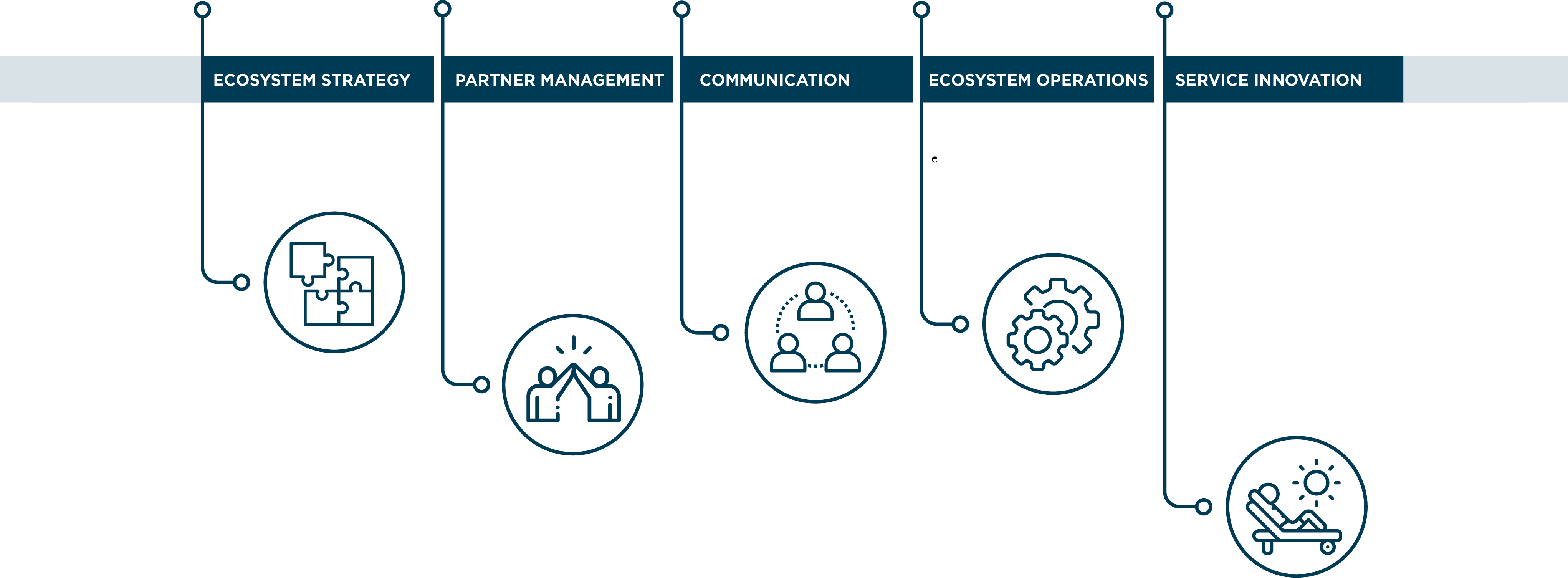Today, your ability to attract and retain customers is no longer just a goal—it's the driving force behind your success. Traditionally, businesses in search of ways to deepen and extend their digital relationships would either build the technologies in-house or acquire them externally. While there are merits to these growth strategies, the complexity of delivering the seamless experiences customers expect today demands a more innovative approach. Enter the digital ecosystem—a model that leverages strategic partnerships to extend your market reach and deliver exceptional customer experiences faster than ever before.
For a deeper look into how to create a next-level digital ecosystem strategy, download our eBook, Execute a Winning Digital Business Ecosystem Strategy—No Matter Your Industry. This blog serves as a sneak peek into the strategies that can help you stay ahead of the curve.
# Advantages of a Digital Ecosystem For Customer Experience Transformation
A digital ecosystem enables businesses to move further and faster in their customer experience transformation journey. By activating strategic partners within your ecosystem, you no longer need to single-handedly source every necessary skillset or predict the next digital innovation to enhance your customer experience initiatives. The benefits are numerous, from accelerating the delivery of new services to improving customer satisfaction across all touchpoints.
# What is a Digital Ecosystem?
A digital ecosystem is a network of interconnected technologies, services, and partnerships that work together to enhance the overall customer experience. It goes beyond traditional business models by integrating external partners to deliver a unified experience across multiple touchpoints. We call this approach a digital business ecosystem model. It leverages strategic partnerships to expand your total addressable market while providing differentiated services that meet your customers right where they are.
# Successful Implementation of Digital Ecosystems
Successfully implementing a digital ecosystem requires more than just assembling the right technologies and partners—it demands a strategic approach that aligns with your long-term business goals. A well-planned digital ecosystem can deliver immense benefits, but only if it is carefully designed and executed with a clear vision. Here are four ways you can ensure that your digital ecosystem strategy leads to meaningful transformation.
# Think Strategically
To truly capitalize on a digital ecosystem, companies need to think deeply about how it will impact the customer experience journey. This involves mapping out each customer touchpoint and determining how the ecosystem can enhance or streamline those interactions. By focusing on strategic implementation rather than just the convenience of integrating new tools, businesses can create a cohesive and effective digital ecosystem.
Related Content: The 7 Best Business Strategy Books to Read in 2024
# Favor Strategy Over Convenience
While quick solutions and small tweaks may seem appealing, prioritizing long-term gains is essential for building a successful digital ecosystem. It’s easy to be tempted by convenient options that offer immediate results, but these often lack the strategic alignment necessary for sustained success. Instead, focus on making decisions that support your broader business objectives, even if they require more time and effort upfront. By doing so, you ensure that your ecosystem not only meets current needs but also evolves with your business and customer expectations, providing lasting value over time.
# Create a Specific Long-Term Vision
A successful digital ecosystem is built on a clear, long-term vision that guides every partnership and technology integration. This vision should reflect your company's strategic objectives and the desired outcomes for your customers. By aligning your ecosystem with this vision, you can create a roadmap for innovation that drives continuous improvement and growth.
# Create a Plan For Adoption
A well-defined plan for adoption involves not only selecting the right technologies and partners, but also ensuring that your organizational model supports the seamless integration of these new elements. Training, communication, and change management are key components of a successful adoption strategy that keeps your entire organization aligned and moving forward.
Need a hand figuring out the details? Propeller’s experience design experts can guide you down the right path. If you’re looking for custom-built solutions to shape your organization’s digital ecosystem in a way that leverages human-centric design philosophies and innovative approaches, contact us today.
Activating strategic partners in your digital ecosystem means you no longer have to go it alone, source every skillset needed, or successfully predict the next digital innovation in order to boost your customer experience initiatives and outcomes.
# Improve Customer Experience Quickly
Digital ecosystems can grow and improve the customer experience—quickly—through the integration of external services and technology. For example, the healthcare industry has capitalized on digital ecosystem strategy to accelerate digitization and improve the patient experience through various touchpoints on a patient’s journey from appointment scheduling to telehealth to electronic prescriptions.
# Complement Your Brand & Future-Proof Your Digital Presence
A mature digital business ecosystem is defined by its ability to engage partners that both complement your brand and future-proof your digital presence—without excluding competition. This requires a big view of your platforms, experiences, services, and products—followed by a mapping of the steps needed to strategically integrate with partner innovators.
Related Content: Three Questions to Assess Your CX Strategy
# Drive Digital-First Innovation Across Your Business
The ability to quickly implement cutting-edge solutions is critical to staying ahead, and a well-structured digital ecosystem makes this possible. Digital ecosystems are catalysts for driving a digital-first mindset across your organization. By integrating external partners and technologies, you can rapidly modernize your business processes and create an environment where innovation thrives. This approach not only accelerates the adoption of new technologies but also ensures that your organization remains agile and competitive in an increasingly digital world.
# Ecosystem Advantages Benefit Every Industry
Responding to customers' needs better, faster, and in more innovative ways is an urgent priority, especially when one poor customer experience can cause your customers to leave for competitors. That’s why digital ecosystems have become indispensable, regardless of sector. In retail, they streamline operations and personalize shopping experiences, leading to higher customer engagement and sales. In tech, ecosystems accelerate innovation and integration, enabling rapid adaptation to emerging trends and technologies. In healthcare, they improve patient care and streamline processes, resulting in better outcomes and enhanced service delivery. In utilities, digital ecosystems optimize resource management and customer service, driving operational efficiency and sustainability. Across all industries, these ecosystems foster greater agility and responsiveness, helping organizations stay competitive and meet evolving customer needs. When companies take the time to strategically build a value-added digital ecosystem, they often find themselves capable of setting and accomplishing larger experiential customer improvements faster.
In spite of their necessity, building a business ecosystem is a highly complex undertaking. To help demystify the process and aid you with strategies, we at Propeller have created an eBook, Execute a Winning Digital Business Ecosystem Strategy—No Matter Your Industry, that goes deeper into the benefits and challenges of a partnership ecosystem. We also share 5 best practices for building the optimal value-add business ecosystem. These apply to any industry in search of faster growth:

- Ecosystem strategy
- Partner management
- Communication
- Ecosystem operations
- Service innovation
Ready to take your digital ecosystem above and beyond? Contact Propeller today to learn more about how we interact with our clients in authentic partnership to help you meet and exceed your goals.
5 Best Practices to Build, Manage, and Scale a Digital Business Ecosystem
# Acquiring a Digital Ecosystem: How Do You Sell It?
To start, you need to identify your leadership and team’s common fears and misconceptions around building a partner ecosystem. This can help you better define the advantages and set the right context for the change. Here are some compelling ecosystem advantages to share:
- A comprehensive business ecosystem helps you execute strategies faster, better, and bigger throughout the collective customer experience.
- Partnering with experts CAN happen simultaneously without creating vulnerability to things like cyber-attacks and litigation.
- Onboarding ecosystem core capabilities (such as data and analytics) can help you activate experiential mobile and personalization capabilities, supply chain advantages, and solutions like chatbots that can help remove barriers to your services.
- An ecosystem opens the door for you to consider alliances with vendors that are innovators—digitally native players who already know how to deliver an intuitive and seamless customer experience.
# The Digital Ecosystem End Goal: Improving Customer Experience and Building Brand Loyalty
Ultimately, the goal of building a digital ecosystem is to enhance the customer experience, which in turn builds brand loyalty and drives revenue growth. Companies like the United Kingdom’s Zoopla Property Group (ZPG) are leveraging digital ecosystems to create integrated networks that significantly enhance customer experiences and build loyalty in the marketplace. By connecting various services within the housing market—such as property listings, mortgage comparisons, and home improvement solutions—ZPG has developed a seamless ecosystem that meets diverse customer needs in one place. This integrated approach not only simplifies the customer journey but also strengthens ZPG’s brand by offering a comprehensive, value-added experience.
The success of companies like ZPG highlights the transformative potential of digital ecosystems in driving customer experience improvements. As these ecosystems grow, they contribute to what could potentially be a $60 trillion integrated network economy by 2025. For businesses, the ability to collaborate with partners and deliver end-to-end solutions through such ecosystems is becoming a key differentiator in building lasting customer loyalty and sustaining competitive advantage.




